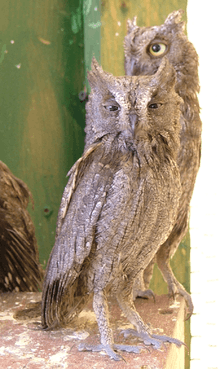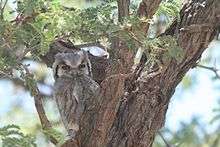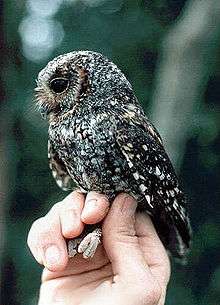Scops owl
Scops owls are typical owls in family Strigidae, most of them belonging to the genus Otus and are restricted to the Old World. Otus is the largest genus of owls in terms of number of species, with approximately 45 living species known to date. Scops owls are colored in various brownish hues, sometimes with a lighter underside and/or face, which helps to camouflage them against the bark of trees. Some are polymorphic, occurring in a greyish- and a reddish-brown morph. They are small and agile, with both sexes being compact in size and shape. Female scops owls are usually larger than males.
| Scops owls | |
|---|---|
 | |
| Eurasian scops owls, Otus scops | |
| Scientific classification | |
| Kingdom: | Animalia |
| Phylum: | Chordata |
| Class: | Aves |
| Order: | Strigiformes |
| Family: | Strigidae |
| Genus: | Otus Pennant, 1769 |
| Diversity | |
| Around 45 species | |
| Synonyms | |
|
Scops Savigny, 1809 | |
For most of the 20th century, this genus included the American screech owls, which are now again separated in Megascops based on a range of behavioral, biogeographical, morphological and DNA sequence data.
Etymology
The name is derived from the Latin word otus and the Greek word "otos" meaning eared owl.[1]
Taxonomy

The generic name Otus was proposed by Thomas Pennant in 1769 for the Indian scops owl (O. bakkamoena).[2] The generic name Scops was proposed by Marie Jules César Savigny in 1809.[3]
By the mid-19th century, it was becoming clear that Otus encompassed more than one genus. First, in 1848, the screech owls were split off as Megascops. The white-faced owls of Africa, with their huge eyes and striking facial coloration, were separated in Ptilopsis in 1851. In 1854, the highly apomorphic white-throated screech owl of the Andes was placed in the monotypic genus Macabra. Gymnasio was established in the same year for the Puerto Rican owl, and the bare-legged owl (or "Cuban screech owl") was separated in Gymnoglaux the following year; the latter genus was sometimes merged with Gymnasio by subsequent authors. The Palau owl, described only in 1872 and little-known to this day, was eventually separated in Pyrroglaux by Yoshimaro Yamashina in 1938.
In the early 20th century, the lumping-together of taxa had come to be preferred. The 3rd edition of the AOU checklist in 1910 placed the screech owls back in Otus. Although this move was never unequivocally accepted, it was the dominant treatment throughout most of the 20th century. In 1988 it was attempted to resolve this by re-establishing all those genera split some 140 years earlier at subgenus rank inside Otus.[4] Still, the diversity and distinctness of the group failed to come together in a good evolutionary and phylogenetic picture, and it was not until the availability of DNA sequence data that this could be resolved. In 1999, a preliminary study of mtDNA cytochrome b across a wide range of owls found that even the treatment as subgenera was probably unsustainable and suggested that most of the genera proposed around 1850 should be accepted.[5] Though there was some debate about the reliability of these findings at first,[6] they have been confirmed by subsequent studies. In 2003, the AOU formally re-accepted the genus Megascops again.[7]


The flammulated owl has been found to be marginally closer to the screech owls than to the scops owls, but by no means robustly or reliably so.[5] If the scops and screech owl clade indeed originated in the Old World, the flammulated owl's ancestors either colonized the Americas independently from but at about the same time and from much the same stock as the screech owls', or they diverged immediately after the latter had settled in the New World. In any case, "Otus" flammeolus now usually warrants separation in its own monotypic genus as this would best agree with the available data.[6] It has been retained in Otus simply because it does not have the characteristic "song" or rapid trill of Megascops.
Species
- Giant scops owl, Otus gurneyi
- White-fronted scops owl, Otus sagittatus
- Andaman scops owl, Otus balli
- Reddish scops owl, Otus rufescens
- Sulu reddish scops owl, Otus rufescens burbidgei – doubtfully distinct, extinct (mid-20th century)
- Sandy scops owl, Otus icterorhynchus
- Sokoke scops owl, Otus ireneae
- Flores scops owl, Otus alfredi
- Mountain scops owl, Otus spilocephalus
- Rajah scops owl, Otus brookii
- Javan scops owl, Otus angelinae
- Mentawai scops owl, Otus mentawi
- Collared scops owl, Otus lettia
- Indian scops owl, Otus bakkamoena
- Sunda scops owl, Otus lempiji
- Japanese scops owl, Otus semitorques
- Wallace's scops owl, Otus silvicola
- Palawan scops owl, Otus fuliginosus
- Philippine scops owl, Otus megalotis
- Everett's scops owl, Otus everetti
- Negros scops owl, Otus nigrorum
- Mindanao scops owl, Otus mirus
- Luzon scops owl, Otus longicornis
- Mindoro scops owl, Otus mindorensis
- Pallid scops owl, Otus brucei
- African scops owl, Otus senegalensis
- Annobón scops owl, Otus feae – formerly included in O. senegalensis
- Arabian scops owl, Otus pamelae
- Socotra scops owl, Otus socotranus
- Eurasian scops owl, Otus scops
- Cyprus scops owl, Otus cyprius
- Madeiran scops owl, Otus mauli (extinct, c. 15th century)
- São Miguel scops owl, Otus frutuosoi (extinct, c. 15th century)
- Oriental scops owl, Otus sunia
- Moluccan scops owl, Otus magicus
- Rinjani scops owl, Otus jolandae[8] – formerly included in O. magicus

- Mantanani scops owl, Otus mantananensis
- Ryūkyū scops owl, Otus elegans
- Sulawesi scops owl, Otus manadensis
- Sula scops owl, Otus sulaensis
- Siau scops owl, Otus siaoensis
- Sangihe scops owl, Otus collari
- Biak scops owl, Otus beccarii
- Seychelles scops owl, Otus insularis
- Simeulue scops owl, Otus umbra
- Enggano scops owl, Otus enganensis
- Nicobar scops owl, Otus alius
- Pemba scops owl, Otus pembaensis
- Karthala scops owl, Otus pauliani
- Anjouan scops owl, Otus capnodes
- Moheli scops owl, Otus moheliensis
- Rainforest scops owl, Otus rutilus
- Mayotte scops owl, Otus mayottensis – formerly included in O. rutilus
- Torotoroka scops owl, Otus madagascariensis – formerly included in O. rutilus
- Serendib scops owl, Otus thilohoffmanni
- São Tomé scops owl, Otus hartlaubi
- Flammulated owl, Psiloscops flammeolus – provisionally placed here
An apparent Otus owl was heard calling at about 1,000 meters ASL south of the summit of Camiguin in the Philippines on May 14, 1994. No scops owls had previously known from this island, and given that new species of Otus are occasionally discovered, it may have been an undescribed taxon.[9][10]
In July 2016, an unknown Otus species was photographed on Príncipe. The image was published on Ornithomedia.[11]
Formerly placed here
As noted above, the fossil record of scops owls gives an incomplete picture of their evolution at present. While older sources cite many species of supposed extinct Otus (or "Scops"), these are now placed in entirely different genera:[12]
- "Otus" henrici was a barn owl of the genus Selenornis
- "Otus" providentiae was a burrowing owl, probably a paleosubspecies
- "Otus" wintershofensis may be close to extant genus Ninox and some material assigned to it belongs into Intutula
- "Scops" commersoni is a junior synonym of the recently extinct Mauritius owl, referring to pictures and descriptions which mention ear tufts; the subfossil material of this species had been erroneously assigned to tuftless owls.
Evolution
The evolutionary relationships of the scops and screech owls are not entirely clear. What is certain is that they are very closely related; they may be considered sister lineages which fill essentially the same ecological niche in their allopatric ranges. A screech-owl fossil from the Late Pliocene of Kansas[13] – which is almost identical to eastern and western screech owls – indicate a long-standing presence of these birds in the Americas, while coeval scops owl fossils very similar to the Eurasian scops-owl have been found at S'Onix on the Spanish island Majorca.[12] The scops and screech owl lineage probably evolved at some time during the Miocene (like most other genera of typical owls), and the three (see below) modern lineages separated perhaps roughly 5 million years ago. Note that there is no reliable estimate of divergence time, as Otus and Megascops are osteologically very similar, as is to be expected from a group that has apparently conserved its ecomorphology since before its evolutionary radiation. As almost all scops and screech owls today, their common ancestor was in all probability already a small owl, with ear tufts and at least the upper tarsus ("leg") feathered.
However that may be, the hypothesis that the group evolved from Old World stock[14] is tentatively supported by cytochrome b sequence data.[5][15]
Ecology and behaviour
While late 19th-century ornithologists knew little of the variation of these cryptic birds which often live in far-off places, with every new taxon being described a few differences between the Old and New World "scops" owls became more and more prominent. Namely, the scops owls give a whistling call or a row of high-pitched hoots with less than four individual hoots per second. This call is given in social interaction or when the owl tries to scare away other animals. The screech owls on the other hand are named for their piercing trills of more than four individual notes per second. They also have a kind of song, which is a short sequence of varying calls given by the males when they try to attract females to their nests, or between members of a pair. There are a few other differences such as the screech owls almost never being brown below which is common in scops owls, but the difference in vocalizations is most striking.
Scops owls hunt from perches in semi-open landscapes. They prefer areas which contain old trees with hollows; these are home to their prey which includes insects, reptiles, small mammals such as bats and mice and other small birds. The owls will also eat earthworms, amphibians and aquatic invertebrates.[16] Scops owls have a good sense of hearing which helps them locate their prey in any habitat. They also possess well-developed raptorial claws and a curved bill, both of which are used for tearing their prey into pieces small enough to swallow easily.
Scops owls are primarily solitary birds. Most species lay and incubate their eggs in a cavity nest that was originally made by another animal. During the incubation period, the male will feed the female. These birds are monogamous, with biparental care, and only fledge one young per year. The young of most scops owls are altricial to semialtricial.
As opposed to screech owls, scops owls have only a single type of call. This consists of a series of whistles or high-pitched hoots, given with a frequency of 4 calls per second or less, or of a single, drawn-out whistle. Calls differ widely between species in type and pitch, and in the field are often the first indication of these birds' presence, as well as the most reliable means to distinguish between species. Some, like the recently described Serendib scops owl (Otus thilohoffmanni), were discovered because their vocalizations were unfamiliar to experts in birdcalls.
References
- Jobling, J.A. (2010). "Otus". The Helm Dictionary of Scientific Bird Names. London: Christopher Helm. p. 286. ISBN 978-1-4081-2501-4.
- Pennant, T. (1769). "Otus bakkamoena". Indian Zoology. London. p. 3.
- Savigny, M.J.C. (1809). "Scops Ephialtes. Le petit duc". Description de l'Égypte, ou recueil des observations et des recherches qui ont été faites en Égypte. I. Paris: L'Imprimerie Impériale. p. 107.
- Marshall, J. T.; King, B. (1988). "Genus Otus". In Amadon, D.; Bull, J. (eds.). Hawks and owls of the world: A distributional and taxonomic list. Proceedings of the Western Foundation of Vertebrate Zoology. 3. pp. 296–357.
- Heidrich, P.; König, C. & Wink, M. (1995). "Molecular phylogeny of the South American Otus atricapillus complex (Aves Strigidae) inferred from nucleotide sequences of the mitochondrial cytochrome b gene" (PDF). Zeitschrift für Naturforschung C. 50 (3–4): 294–302.
- South American Classification Committee (SACC) (2003). "Proposal (#58): Elevate subgenus Megascops (New World Otus) to full generic status". Archived from the original on 2008-05-16.
- Banks, R. C.; Cicero, C.; Dunn, J. L.; Kratter, A. W.; Rasmussen, P. C.; Remsen, J.V. Jr.; Rising, J. D. & Stotz, D. F. (2003). "Forty-fourth supplement to the American Ornithologists' Union check-list of North American birds" (PDF). Auk. 120 (3): 923–931. doi:10.1642/0004-8038(2003)120[0923:fsttao]2.0.co;2.
- Sangster, G.; King, B. F.; Verbelen, P. & Trainor, C. R. (2013). "A New Owl Species of the Genus Otus (Aves: Strigidae) from Lombok, Indonesia". PLoS ONE. 8 (2): e53712. doi:10.1371/journal.pone.0053712. PMC 3572129. PMID 23418422.
- Balete, D. S.; Tabaranza, B. R. Jr. & Heaney, L. R. (2006). "An Annotated Checklist of the Birds of Camiguin Island, Philippines". Fieldiana Zoology. New Series. 106: 58. doi:10.3158/0015-0754(2006)106[58:AACOTB]2.0.CO;2.
- Heaney, L. R. & Tabaranza, B. R. Jr. (2006). "Mammal and Land Bird Studies on Camiguin Island, Philippines: Background and Conservation Priorities". Fieldiana Zoology. New Series. 106: 1–13. doi:10.3158/0015-0754(2006)106[1:MALBSO]2.0.CO;2.
- "An unknown bird of the island of Príncipe has been photographed" (in French). Ornithomedia. 2016. Retrieved 10 August 2016.
- Mlíkovský, J. (2002). Cenozoic Birds of the World, Part 1: Europe. Prague: Ninox Press.
- Ford, N. L. (1966). "Fossil Owls From the Rexroad Fauna of the Upper Pliocene in Kansas" (PDF). Condor. 68 (5): 472–475. doi:10.2307/1365319.
- Johnson, D. (2003). "Owls in the Fossil Record". The owl pages.
- Wink, M. & Heidrich, P. (1999). "Molecular evolution and systematics of owls (Strigiformes)" (PDF). In König, C.; Weick, F. & Becking, J.H. (ed.). A guide to the owls of the world. New Haven: Yale University Press. pp. 39–57. ISBN 0-300-07920-6.CS1 maint: multiple names: authors list (link)
- Marchesi, L. & Sergio, F. (2005). "Distribution, density, diet and productivity of the Scops Owl Otus scops in the Italian Alps". Ibis. 147 (1): 176–187. doi:10.1111/j.1474-919x.2004.00388.x.
External links
| Wikispecies has information related to Otus |
| Wikimedia Commons has media related to Otus. |